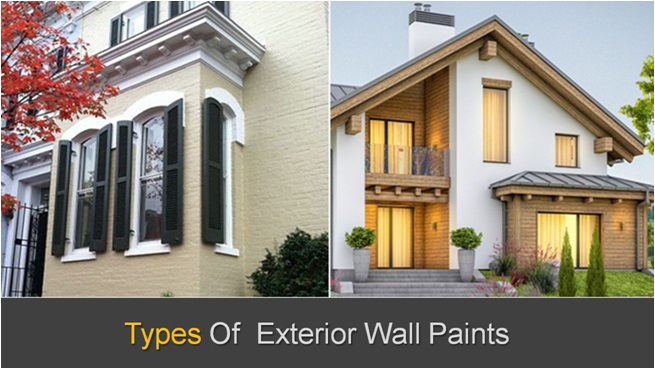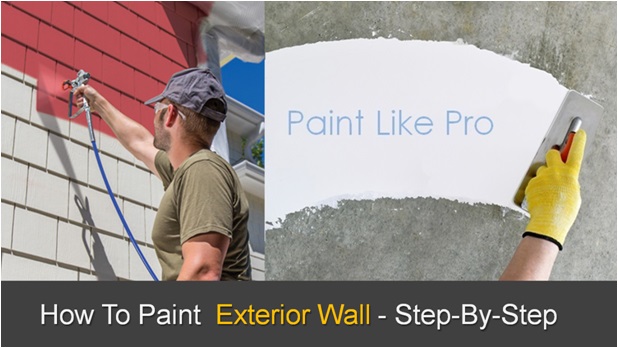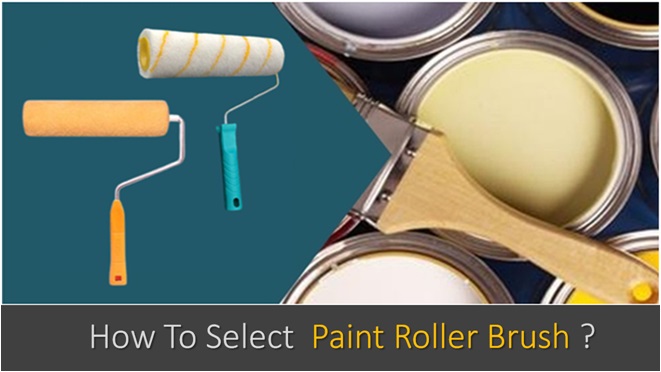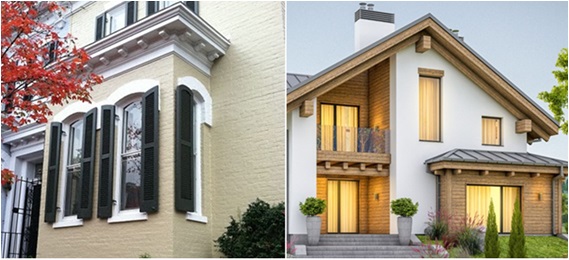
Types Of Exterior Wall Paints
Different types of exterior wall paints are available, specially designed for specific applications. The exterior wall paint provides protection and elegance to the building façade. Therefore, the exterior wall paint plays an important role in house maintenance and the safety of your property.
The home improvement store offers you a wide range of options for the selection of exterior wall paint. Paint technology has also rapidly evolved, and new generations of exterior paint products offer some major benefits.
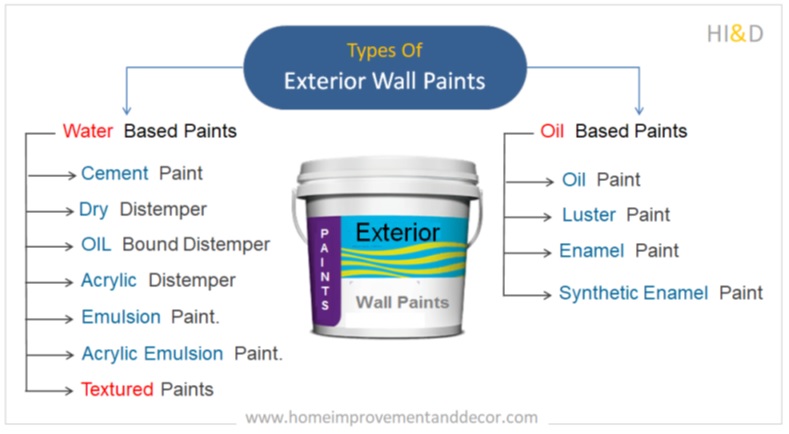
Each leading brand present in the exterior paint market has a number of options to choose from. Each product in this category offers many features with some specific advantages.
The types of exterior wall paint are similar to the interior paints. Exterior wall paints can be grouped into two main types.
Exterior Wall Paint Types
What Are The Different Types Of Exterior Wall Paints ?
Exterior Paint Type | General Information | Suitable For Surface | Average Lifespan | |
1 | Cement Paints. | General purpose affordable water based exterior paint. | Brick wall , cement plaster , concrete surfaces. | Cement Paints lasts between 2 to 3 years. . |
2 | Emulsion Paints. | General purpose affordable water based exterior paint. | Brick wall , cement plaster , concrete surfaces. | Emulsion Paints lasts between 2 to 5 years. . |
3 | Acralic Emulsion Paints. | General purpose superior quality water based exterior paint. | Brick wall , cement plaster , concrete and wooden surfaces. | Acralic Emulsion Paints lasts between 5 to 8 years. . |
4 | Texture Paints. | Special purpose superior quality water based textured exterior paint. | Brick wall , cement plaster , concrete surfaces. | Textured Paints lasts between 5 to 10 years. . |
The first category of exterior paint is water-based paints. The water-based paints are also alternately referred to as latex paints or emulsion paints.
The second category of exterior paints is oil-based paints. The oil-based paint requires oil thinners to dilute the paint in order to get the desired consistency of paint at the time of its application.
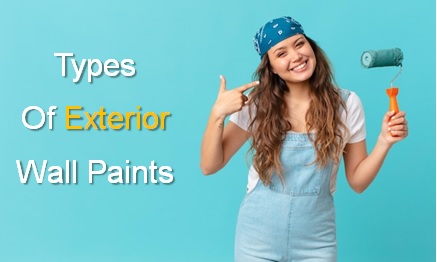
In this article, we will discuss different types of exterior paints available on the market and their respective features and benefits. This information is crucial for any exterior painting DIY project to get professional results.
Let us find out how to select the best paint type for your DIY project.
How To Paint Exterior Walls ?
Types Of Exterior Wall Paints
Table Of Contents
- Textured Exterior Paints.
- Emulsion Paints.
- Acrylic Emulsion Paints.
- Exterior Primer Paints.
Water Based Exterior Wall Paints
The water-based paint is the most commonly used exterior paint and is available in all home improvement stores.
All major paint brands have a strong presence in this category of paint. There are a number of exterior emulsion paints available under different product names.
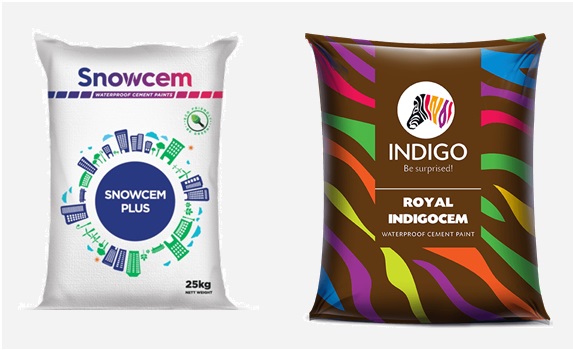
These water-based exterior paints are also referred to as latex paints or emulsion paints. These paints can be easily diluted using water to get the required consistency.
The water-based exterior paints offer many options for the selection of exterior paints with many features. These paints can be applied with the help of brush , paint roller and spray gun.
The cement based paints must be used within the period recommended and mentioned on the product description.
Important Tips
It is important to read the instructions mentioned on the product.
Some ready-to-use paints do not need any type of thinner. These paints can be directly applied on the wall surface after the surface preparation. All paints must be stirred well prior to use.
Oil Based Exterior Wall Paints
Solvent Based Paints
The second type of exterior paint is oil-based paint. For these paints, oil-based solvents ( paint thinners ) are used to dilute the paint to get the required consistency.
The use of oil-based paints for external application is declining due to advancements in water-based paints.
The oil-based paints render a strong, long-lasting and superior finish. And that makes exterior paints an excellent choice for exterior paints.
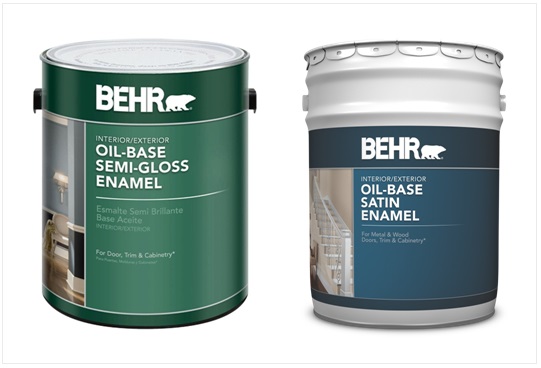
However, the oil-based paints need proper treatment of the external wall surface prior to the application of the paint. The oil-based paints also take a long time to dry and therefore have a longer time gap between the two paint coats.
The oil-based paints also emit fumes in the form of volatile organic compounds (VOC) that have a strong odor. These paint need dry conditions for best results.
The oil-based paints also need a stable surface and tend to form cracks on external wooden surfaces. The wooden surface tends to expand and contract depending upon the weather conditions.
Cement Paints
Cement Based Exterior Wall Paints
Cement paint is one of the most commonly used low-cost options for exterior painting. The cement paints are easily available in any home improvement store with a wide range of colors.
The cement paint offers excellent all-weather protection against common problems like water seepage. The cement paint forms an excellent bond with the wall surface due to its cementing properties.
The cement paint is a water-based paint that comes in power form. It needs to be prepared as per the instructions mentioned on the product.
The cement paint is manufactured using the white cement as a base material. Special additives are added into the cement paint, which gives all weather protection.
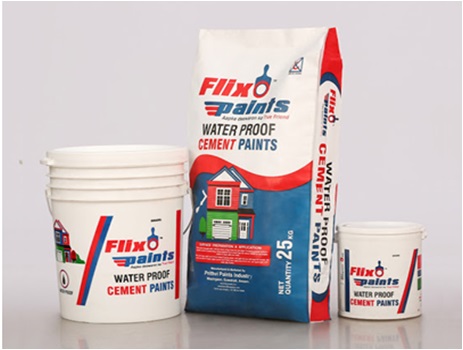
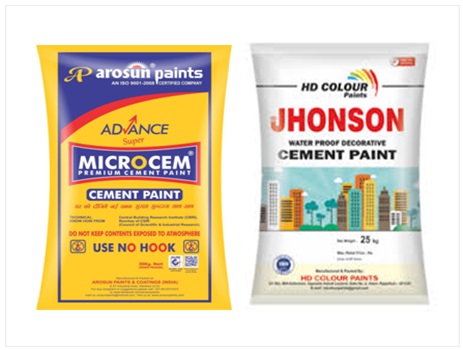
The cement paints are mainly used for exterior painting, but they can also be used on interior walls, especially when the wall is exposed to moist and damp conditions.
The cement paint needs to be cured for a few days, similar to any other cement-based product, to achieve its full strength. However , some companies have launched cement paint that does not need curing.
Important Tips
The cement paint must be prepared in the required quantity as per the product instructions. The cement paint, once prepared, must be consumed immediately.
The cement paint bag must be stored in a dry area and should be protected from moisture and wet conditions.
The cement paint bag, once opened, must be closed properly in order to preserve the cementing property of the paint.
The cementing property of the paint would diminish if it is exposed to moisture during storage.
The cement paint must be cured as per the product usage instructions. The cement paint gains its full strength only after it is cured for the recommended period.
What Is the Curing of Cement Paint ?
The term “curing” is used in the context of all cement products. Curing is the process of retaining the internal moisture added initially to the cement.
The curing can be done by simply covering it with moist gunny bags or by sprinkling water on the surface. For cement paints, curing by sprinkling water is the most practical method.
The cement products gain their strength by a chemical process, and this process needs water to gain full strength. The cement paint should be cured for the recommended period mentioned on the product description.
Advantages Of Cement Paints
- Easy To Apply.
- Most Economical.
- Easy To Maintain.
- Good Coverage.
- Many Color Options.
Features Of Cement Paints
- Water Used As Thinner.
- Curing Required.
- Water Resistant Paint.
- Can Be Used On Damp Walls.
Emulsion Paints
Exterior Grade Emulsion Paints
Emulsion paints are the most commonly used paints in the exterior paint segment. The emulsion paint is a water-soluble paint that is also known as latex paint. All the top paint brands have a number of products in the emulsion paint category, and each paint offers different features.
However , the overwhelming presence of emulsion paints under fancy names adds to the confusion in understanding the technical jargon. The emulsion paints are premium quality paints that come in the category of luxury emulsion paints.
The pricing of the emulsion paint depends upon the brand, special features, and the company’s guaranteed life of the paint.
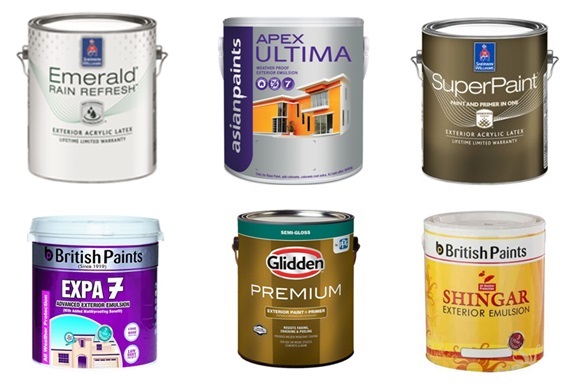
The emulsion paint contains some polymers , resins, and additives that impart some special properties to the paint. The customer can buy the right paint depending on what the user needs. Emulsion paint technology is evolving at a rapid pace, and the paint companies are adding new products with advanced features.
The emulsion paint can be applied only on the prepared exterior wall surface. The surface preparation includes sealing the wall cracks and the application of cement primer.
Important Tips
The self-priming category of emulsion paints ( two-in-one paints ) is a special paint that also includes the primer. Therefore, such paints do not need a primer coat. The emulsion paint can be directly applied to the wall surface.
The emulsion paint is available in both glossy and matte paint finishes. The paint finish is prominently mentioned on the paint cans. The emulsion paint can be diluted using clean water to get the required consistency. However, please check the product usage instructions before it is diluted.
In some cases, the paint is directly applied on the exterior wall surface without adding water as a thinner.
Advantages Of Emulsion Paints
- Easy To Apply.
- Long Life.
- Easy To Maintain.
- Good Coverage.
- Many Color Options.
Features Of Emulsion Paints
- Water Resistant.
- Anti-Fungal.
- Stain Resistant Paint.
- Quick Drying Paint.
- Crack Resistant.
Texture Paints
What Are Texture Exterior Paints ?
The use of texture paints for exterior walls is growing. The texture wall paint gives a uniform, elegant and textured look to the building façade. The textured paint, apart from its elegant façade, also helps to hide the surface imperfections and micro-cracks.
The texture paints are mostly applied on the exterior walls. However, texture paint can also be used for interior walls to highlight specific part of the interior surface. These paints offer a wide range of textures that can be used as per the interior design.
The wall texture paint can be applied by using two methods.
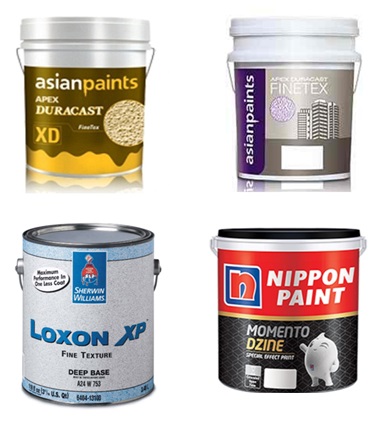
Wall Texture Paint
The First Method to Apply Wall Texture
In the first method, a ready-made texture paint is applied to the wall surface using a special roller brush.
The texture paints in liquid form are readily available in any home improvement store. Generally, two coats of textured paint is sufficient to create a perfect textured wall surface.
The first coat of the texture paint is applied in a vertical direction with the help of a texture roller.
The second coat is applied only after the first coat has dried completely using a special sponge texture roller to be used in the horizontal direction.
Wall Texture Paint
The Second Method of Applying Texture Paint
In the second method, a ready-made texture paint available in the paste form is applied to the wall surface using a special trowel.
This type of texture paint is readily available either in powder or paste form in any home improvement store.
Generally, a single coat of textured paint paste is sufficient to create a perfect textured wall surface.
Different types of texture effects can be created by using various texture paints.
Types Of Wall Texture Paints
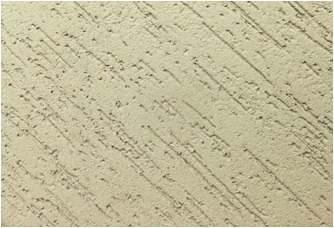
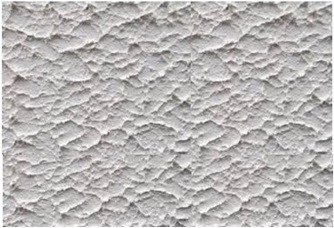
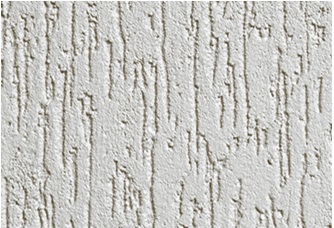
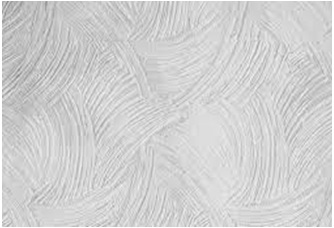
Advantages Of Textured Paints
- Easy To Apply.
- Long Life.
- Hides Imperfections.
- Hides Micro-Cracks.
- Good Coverage.
Features Of Textured Paints
- Water Resistant.
- Anti-Fungal .
- Stain Resistant Paint.
- Quick Drying Paint.
- Crack Resistant.

